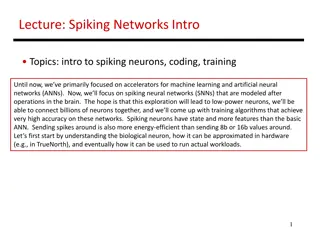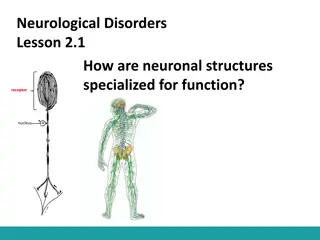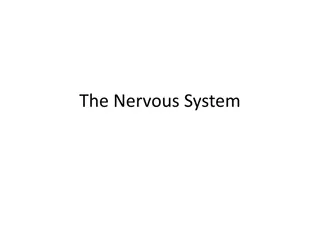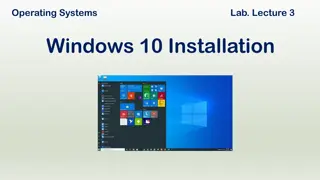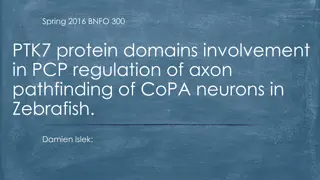Deep Learning with Theano: Installation, Neurons, and Exploration
Delve into the world of deep learning with Peter Podolski's comprehensive guide on utilizing Theano for neural network development. Explore topics such as installation on various systems, working with neurons, and unlocking the potential for CPU and GPU optimization. Discover insights on hidden nodes, mini-batching, and improving speed for CPU-based Theano projects.
Download Presentation

Please find below an Image/Link to download the presentation.
The content on the website is provided AS IS for your information and personal use only. It may not be sold, licensed, or shared on other websites without obtaining consent from the author.If you encounter any issues during the download, it is possible that the publisher has removed the file from their server.
You are allowed to download the files provided on this website for personal or commercial use, subject to the condition that they are used lawfully. All files are the property of their respective owners.
The content on the website is provided AS IS for your information and personal use only. It may not be sold, licensed, or shared on other websites without obtaining consent from the author.
E N D
Presentation Transcript
1 Deep Learning Cont. Peter Podolski Deep Learning with Theano
2 Contents Installation Neurons Cont. Exploring Variations Number of hidden nodes No Mini-batching CPU/GPU Output Nodes Sigmoid
3 Installation Worked with Theano 5 different ways Laptop (CPU) Kong Head node (CPU) Kong cluster (CPU) Kong cluster (GPU) Different Laptop (GPU) We will discuss Theano on Kong Modules Needed Cuda Anaconda Blas-gnu4/openBlas Lapack-gnu4 Atlas Gsl-gnu4
4 Installation Anaconda (Scipy, numpy) Running script with python command with Anaconda module loaded will funnel it through Anconda Theano is now installed on Kong sgescript #$ -l gpu=1 Remove for CPU usage THEANO_FLAGS= floatX=float32, device=gpu0, nvcc.fastmath=True Final command THEANO_FLAGS='floatX=float32,device=gpu0,nvcc.fastmath=True' python <myscript>.py
5 Contents Installation Neurons Cont. Exploring Variations Number of hidden nodes No Mini-batching CPU/GPU Output Nodes Sigmoid
6 Neurons Cont. Sigmoid Tanh(a) ?? ? ? ??+ ? ? ? = ? + ???? ? a = (input w) + b 1 ? = 1 + ? ?
7 Contents Installation Neurons Cont. Exploring Variations Number of hidden nodes No Mini-batching CPU/GPU Output Nodes Sigmoid
8 Hidden Nodes Significant speed-up for CPU-based Theano Reduced from 500 to 200
9 Contents Installation Neurons Cont. Exploring Variations Number of hidden nodes No Mini-batching CPU/GPU Output Nodes Sigmoid
10 Removing Mini-batching Training for a fixed number of epochs Mini-batching important 1 mini-batch vs 20 mini-batches can have significant impact Significant speed-up for CPU-based Theano
11 Original Results Kong Head Node (CPU) w/ Mini-batching (tanh activation) ... loading data ... building the model ... Training epoch 1, minibatch 500/2500, validation error 15.140000 % epoch 1, minibatch 500/2500, test error of best model 15.720000 % epoch 1, minibatch 1000/2500, validation error 11.630000 % epoch 1, minibatch 1000/2500, test error of best model 12.120000 % epoch 1, minibatch 1500/2500, validation error 10.550000 % epoch 1, minibatch 1500/2500, test error of best model 11.140000 % epoch 1, minibatch 2000/2500, validation error 10.070000 % epoch 1, minibatch 2000/2500, test error of best model 10.380000 % epoch 1, minibatch 2500/2500, validation error 9.620000 % epoch 1, minibatch 2500/2500, test error of best model 10.090000 % Optimization complete. Best validation score of 9.620000 % obtained at iteration 2500, with test performance 10.090000 % The code for file mlpTest.py ran for 19.08m
12 Results Kong Head Node (CPU) w/ No Mini-batching (tanh activation) epoch 1, minibatch 2500/2500, validation error 10.180000 % epoch 1, minibatch 2500/2500, test error of best model 10.700000 % epoch 2, minibatch 2500/2500, validation error 8.620000 % epoch 2, minibatch 2500/2500, test error of best model 8.920000 % epoch 29, minibatch 2500/2500, test error of best model 3.380000 % epoch 30, minibatch 2500/2500, validation error 2.980000 % epoch 30, minibatch 2500/2500, test error of best model 3.360000 % Optimization complete. Best validation score of 2.980000 % obtained at iteration 75000, with test performance 3.360000 % The code for file mlpTest.py ran for 12.82m
13 Contents Installation Neurons Cont. Exploring Variations Number of hidden nodes No Mini-batching CPU/GPU Output Nodes Sigmoid
14 CPU/GPU Kong Head Node (GPU) w/ No Mini-batching (tanh activation) epoch 1, minibatch 2500/2500, validation error 10.180000 % epoch 1, minibatch 2500/2500, test error of best model 10.700000 % epoch 2, minibatch 2500/2500, validation error 8.620000 % epoch 2, minibatch 2500/2500, test error of best model 8.920000 % epoch 29, minibatch 2500/2500, validation error 3.020000 % epoch 29, minibatch 2500/2500, test error of best model 3.380000 % epoch 30, minibatch 2500/2500, validation error 2.980000 % epoch 30, minibatch 2500/2500, test error of best model 3.360000 % Optimization complete. Best validation score of 2.980000 % obtained at iteration 75000, with test performance 3.360000 % 2 and 17 seconds
15 Contents Installation Neurons Cont. Exploring Variations Number of hidden nodes No Mini-batching CPU/GPU Output Nodes Sigmoid
16 Output Nodes Results Kong Head Node (GPU) w/ No Mini-batching (tanh activation) 10 Nodes epoch 100, minibatch 2500/2500, validation error 2.130000 % Optimization complete. Best validation score of 2.130000 % obtained at iteration 245000, with test performance 2.190000 %
17 Output Nodes Results Kong Head Node (GPU) w/ No Mini-batching (tanh activation) 20 Nodes epoch 100, minibatch 2500/2500, validation error 2.070000 % Optimization complete. Best validation score of 2.070000 % obtained at iteration 250000, with test performance 2.100000 %
18 Contents Installation Neurons Cont. Exploring Variations Number of hidden nodes No Mini-batching CPU/GPU Output Nodes Sigmoid
19 Sigmoid Results Kong Head Node (GPU) w/ No Mini-batching (sigmoid activation) epoch 100, minibatch 2500/2500, validation error 3.410000 % Optimization complete. Best validation score of 3.410000 % obtained at iteration 250000, with test performance 3.650000 %
20 Multilayer Perception Code MLP Constructor classifier = MLP( rng=rng, input=x, n_in=28 * 28, n_hidden=n_hidden, n_out=10 )










